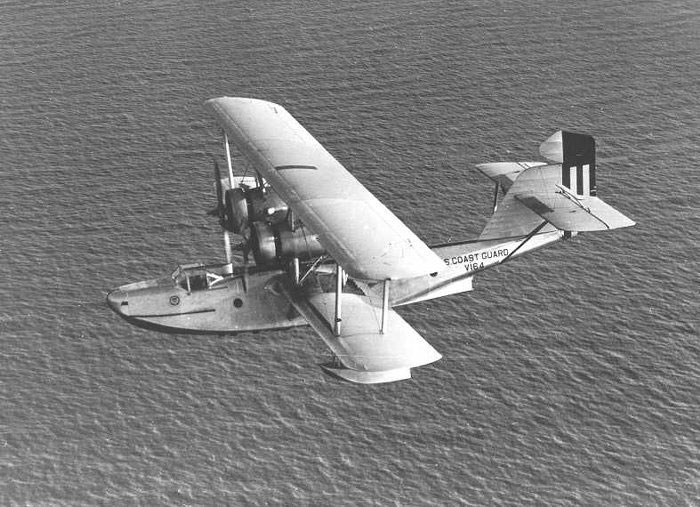
The Hall Aluminum Aircraft Corporation produced a prototype flying-boat design in 1929 on a US Navy contract. They subsequently received orders for nine flying-boats which were designated as PH-1. Made largely of aluminum, it was a state of the art aircraft when it first flew. In 1936 the Coast Guard was looking for a replacement for the General Aviation PJ Flying Lifeboats. They approached the Hall Corporation and contracted for seven modified Hall flying boats, designated PH-2, which were delivered in 1938.
The Hall PH-2 aircraft were biplanes with fabric covered aluminum alloy structured wings and tail surfaces. The hull and wing tip floats were aluminum alloy. The hull design was clean and built up around five bulkheads which divided into six watertight compartments. The empennage was large and up well clear of spray providing excellent control in choppy seas. As many as 20 passengers or survivors could be accommodated. The power plants were upgraded to the more powerful supercharged 750 hp Wright Cyclone engine. The propellers were three blade, constant speed CS32D manufactured by Curtiss. With a full fuel load the aircraft could fly for 20 hours at135 mph. The landing speed was 61mph. The aircraft was IFR capable with gyro horizons, directional gyros, and rate of climb instruments. The electrical system was compact and complete. The radio equipment installed was modern and included a direction finder and a two way radiophone. A voice amplifying system used to warn people of approaching storms or to relay instructions to ships in distress was also on board. A special beaching gear was utilized which allowed the aircraft to be handled on land and rapidly removed once the aircraft was in the water. Seven additional Hall flying boats, designated PH-3 were ordered in 1939. They differed from the PH-2 in that they were fitted with long-chord NACA engine cowlings and had a more refined cockpit enclosure.
The aircraft was well built and rugged but it was obsolescent. The Engines were mounted between the wings aft of the cockpit and there was some concern that in the event of a hard landing at sea, sufficient force could be developed to tear the engines loose, in which case they would fall forward onto the pilot’s compartment. Some also questioned why the PH-2/3 was chosen over the new series of Navy high wing monoplane flying boats. The answer may lie in the fact that the previous Flying Life Boats were a remarkable achievement and were designed for the Coast Guard mission. When replacement was required the manufacturers had either gone out of business or no longer continued to manufacture this type of aircraft. The cost of development and building a few aircraft for a specific mission would have been extremely high. The Coast Guard chose to adapt and upgrade an obsolescent design to meet current needs.
After the Japanese attack on Pearl Harbor the Hall flying boats were given the standard Navy livery in place of the aluminum paint configuration. They were pressed into service for ant-submarine patrol. Initially unarmed they were modified by Coast Guard personnel to enable them to carry depth charges. They were utilized extensively to direct surface vessels to survivors of torpedoed ships and on a number of occasions they set down in the sea to make a rescue. Prior to the end of the war they were replaced by PBY and PBM aircraft.
Technical Information Hall PH-2/3
|
Manufacturer Hall Aircraft Corporation |
Engine Wright Cyclone F51 R -1820 |
|
Type Patrol Flying Boat |
Propeller Curtiss CS32D |
|
Wing Span 72ft 10in |
Fuel 892 gal |
|
Length 51ft |
Cruise Speed 137mph |
|
Gross Weight 16,457 pounds |
Range 2242 miles |
|
Service Ceiling 21,000 ft |
Crew 5 |
Air Sea Rescue operations became the primary focus from October 1943 on. Between January 1 and December 1, 1944, a total of 124 aircraft went down in waters covered by this squadron. Of the 201 pilots and crewmen involved, 137 were saved, 59 were killed outright by mid-air collisions or impact with the water, two are missing, and three who might have been saved were lost because of improper equipment.

